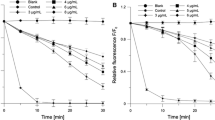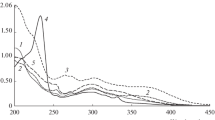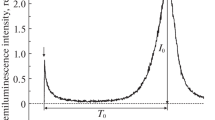Abstract
Black pepper is a source of effective antioxidants. It contains several powerful antioxidants and is thus one of the most important spices for preventing and curtailing oxidative stress. There is considerable interest in the development of a drug-delivery systems that would result in the selective delivery of antioxidants to tissues in sufficient concentrations to ameliorate oxidant-induced tissue injuries. Liposomes are biocompatible, biodegradable and nontoxic artificial phospholipid vesicles that offer the possibility of carrying hydrophilic, hydrophobic and amphiphilic molecules. This article focuses on the use of liposomes for the delivery of antioxidants in the prevention or treatment of pathological conditions related to oxidative stress. Liposome formulations of piperine were analyzed with various spectroscopic methods. The formulation with the highest entrapment efficiency (90.5 %) was formulated with an L-α-phosphatidylcholine dipalmitoyl (DPPC):piperine, 30:1 molar ratio, and total lipid count of 19.47 mg/ml in the final liposomal preparation. The liposome formulation was found to be stable after storage at 4 °C, protected from light, for a minimum of 3 weeks. The incremental process of piperine penetration through the phospholipid membrane was analyzed using the FT-IR, UV-Vis and NMR methods. Temperature stability studies carried out at 37 °C showed the highest percentage of piperine release in the first 3 h of incubation.








Similar content being viewed by others
References
Ahmad N, Fazal H, Abbasi BH, Farooq S, Ali M, Khan MA (2012) Biological role of Piper nigrum L. (Black pepper): a review. Asian Pac J Trop Biomed 2:1945–1953
Andresen TL, Jensen SS (2005) Advanced strategies in liposomal cancer therapy: problems and prospects of active and tumor specific drug release. Prog Lipid Res 44:68–97
Appiah I, Milovanovic S, Radojicic A, Nikolic-Kokic A, Orescanin-Dusic Z, Slavic M, Trbojevic S, Skrbic R, Spasic MB, Blagojevic D (2009) Hydrogen peroxide affects contractile activity and anti-oxidant enzymes in rat uterus. Br J Pharmacol 158:1932–1941
Berger S, Sicker D (2009) Classics in spectroscopy, isolation and structure elucidation of natural products. Wiley-VCH, Weinheim
Brand-Williams W, Cuvelier ME, Berset C (1995) Use of a free radical method to evaluate antioxidant activity. LWT—food. Sci Technol 28:25–30
Brewer MS (2011) Natural antioxidants: sources, compounds, mechanisms of action, and potential applications. Compr Rev Food Sci F 10:221–247
Brown ML, Venable RM, Pastor RW (1995) A method for characterizing transition concertedness from polymer dynamics computer simulations. Biopolymers 35:31–46
Crowe JH, Hoekstra FA (1989) Membrane phase transitions are responsible for imbibitional damage in dry pollen. Proc Nat Acad Sci USA 86:520–523
Damanhouri ZA, Ahmad A (2014) A review on therapeutic potential of Piper nigrum L. (black pepper): the king of spices. Med Aromat Plants 3:3–6
Exerowa D (2002) Chain-melting phase transition and short-range molecular interactions in phospholipid foam bilayers. Adv Colloid Interfac 96:75–100
Flora SJ (2007) Role of free radicals and antioxidant in health and disease. Cell Mol Biol 15:1–2
Gawrisch K (2005) The structure of biological membranes. In: Yeagle PL (ed) The dynamics of membrane lipids. CRC Press, New York, pp 540–560
Gorrini Ch, Harris IS, Mak TW (2013) Modulation of oxidative stress as an anticancer strategy. Nat Rev Drug Discov 12:931–947
Gregoriadis G (1974) Drug entrapment in liposomes; possibilities for chemotherapy. Biochem Soc Trans 2:117–119
Haulica I, Boisteanu D, Bild W (2000) Free radicals between health and disease. Rom J Physiol 37:15–22
Hirokawa Y, Nheu T, Grimm K (2006) Sichuan pepper extracts block the PAK1/Cyclin D1 pathway and the growth of NF1-deficient cancer xenograft in mice. Cancer Biol Ther 5:305–309
Hirsh DJ, Lazaro N, Wright LR, Boggs JM (1998) A new monofluorinated phosphatidylcholine forms interdigitated bilayers. Biophys J 75:1858–1868
Hu Z, Yang X, Ho PC, Chan SY, Heng PW, Chan E, Duan W, Koh HL, Zhou S (2005) Herb-drug interactions: a literature review. Drugs 65:1239–1282
Huster D, Arnold K (1999) Investigation of lipid organization in biological membranes by two-dimensional nuclear overhauser enhancement spectroscopy. J Phys Chem B 103:243–251
Jin Y, Li M, Hou X (2005) Pyrocatechol violet as a marker to characterize liposomal membrane permeability using the chelation and the first-order derivative spectroscopy. J Pharmaceut Biomed 37:379–382
Kerdudo A, Dingas A, Fernandez X, Faure Ch (2014) Encapsulation of rutin and naringenin in multilamellar vesicles for optimum antioxidant activity. Food Chem 159:12–19
La L, Fu Q, Liu Y (2012) Piperine suppresses tumor growth and metastasis in vitroand in vivo in a 4T1 murine breast cancer model. Acta Pharmacol Sin 33:523–530
Lewis RN, McElhaney RN (2013) Membrane lipid phase transitions and phase organization studied by fourier transform infrared spectroscopy. Bioch Biophys Acta 1828:2347–2358
Namjoyan F, Hejazi H (2012) Evaluation of drying process on the composition of black pepper ethanolic extract by high performance liquid chromatography with diode array detector. Jundishapur J Nat Pharm Prod 7:163–167
Neeraj J, Sing S, Sing J (2013) Role of free radicals and antioxidants in human health and disease. Int J Curr Res Rev 5:14–22
Niu Y, Ke D, Yang Q, Wang X, Chen Z, An X, Shen W (2012a) Temperature-dependent stability and DPPC scavengign activity of liposomal curcumin at pH 7.0. Food Chem 135:1377–1382
Niu Y, Wang X, Chai S, Chen Z, An X, Shen W (2012b) Effects of curcumin concentration and temperature on the spectroscopic properties of liposomal curcumin. J Agr Food Chem 60:1865–1870
Pare Ch, Lafleur M, Liu F (2001) Differential scanning calorimetry and 2H nuclear magnetic resonance and fourier transform infrared spectroscopy studies of the effects of transmembrane α-helical peptides on the organization of phosphatidylcholine bilayers. Biochim Biophys Acta 1511:60–73
Pastor RW, Feller SE (1996) A molecular perspective from computation and experiment. In: Merz KM, Roux B (eds) Biological membranes. Birkhäuser, Boston, pp 3–30
Pawlikowska-Pawlega B, Misiak LE, Zarzyka B, Paduch R, Gawron A, Gruszecki WI (2012) Localization and interaction of genistein with model membranes formed with dipalmitoylphosphatidylcholine (DPPC). Biochim Biophys Acta 1818:1785–1793
Pentak D (2014) Physicochemical properties of liposomes as potential anticancer drugs carriers. Interaction of etoposide and cytarabine with the membrane: spectroscopic studies. Spectrochim Acta A 122:451–460
Popova AV, Hincha DK (2011) Thermotropic phase behavior and headgroup interactions of the nonbilayer lipids phosphatidylethanolamine and monogalactosyldiacylglycerol in the dry state. BMC Biophys 4:1–11
Pradeep CR, Kuttan G (2002) Effect of piperine on the inhibition of lung metastasis induced B16F-10 melanoma cells in mice. Clin Exp Metastas 19:703–708
Priyadarsini KI, Maity DK, Naik GH, Kumar MS, Unnikrishnan MK, Satav JG (2003) Role of phenolic O–H and methylene hydrogen on the free radical reactions and antioxidant activity of curcumin. Free Radical Biol Med 35:475–484
Rodrigues C, Gameiro P (2003) Interaction of rifampicin and isoniazid with large unilamellar liposomes: spectroscopic location studies. Biochim Biophys Acta 1620:151–159
Shang YJ, Jin XL, Shang XL, Tang JJ, Liu GY, Dai F (2010) Antioxidant capacity of curcumin-directed analogues: structure-Activity relationship and influence of microenvironment. Food Chem 119:1435–1442
Sharma A, Sharma US (1997) Liposomes in drug delivery: progress and limitations. Int J Pharm 154:123–140
Sinha R, Joshi A (2014) Localization and interaction of hydroxyflavones with lipid bilayer model membranes: a study using DSC and multinuclear NMR. Eur J Med Chem 80:285–294
Smith HJ, Smith JR (2012) Multi-drug liposomes to treat tumors, Patent Application Publication, Pub. No.: US 2012/0231066 A1, United States
Ulbricht C, Chao W, Costa D (2008) Clinical evidence of herb-drug interactions: a systematic review by the natural standard research collaboration. Curr Drug Metab 9:1063–1120
Upadhyay V, Sharma N, Joshi HM (2013) Development and validation of rapid RPHPLC, method for estimation of piperine in Piper nigrum L. Int J Herb Med 1:6–9
Valko M, Leibfritz D, Moncol J, Cronin MTD, Mazur M, Telser J (2007) Free radicals and antioxidants in normal physiological functions and human disease. Int J Biochem Cell B 39:44–84
Vasavirama K, Upender M (2014) Piperine: a valuable alkaloid from piper species. Int J Pharm Pharm Sci 6:34–38
Vazquez-Olivencia W, Shah P, Pitchumoni CS (1992) The effect of red and black pepper on orocecal transit time. J Am Coll Nutr 11:228–231
Yang J, Calero C, Marti J (2014) Diffusion and spectroscopy of water and lipids in fully hydrated dimyristoylphosphatidylcholine bilayer membranes. J Chem Phys 140:104901–104913
Zarai Z, Boujelbene E, Salem NB (2013) Antioxidant and antimicrobial activities of various solvent extracts, piperine and piperic acid from Piper nigrum. Lwt-Food Sci Technol 50:634–641
Author information
Authors and Affiliations
Corresponding author
Electronic supplementary material
Below is the link to the electronic supplementary material.
Rights and permissions
About this article
Cite this article
Pentak, D. In vitro spectroscopic study of piperine-encapsulated nanosize liposomes. Eur Biophys J 45, 175–186 (2016). https://doi.org/10.1007/s00249-015-1086-x
Received:
Revised:
Accepted:
Published:
Issue Date:
DOI: https://doi.org/10.1007/s00249-015-1086-x




